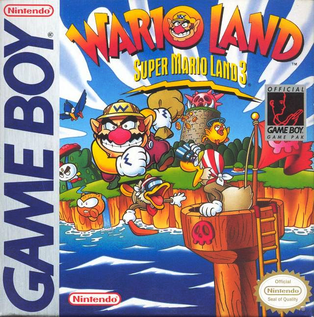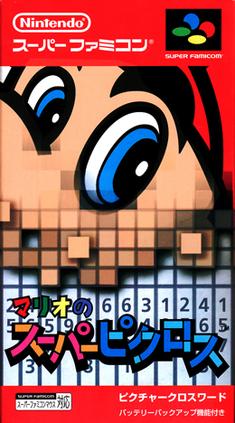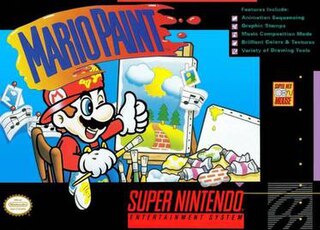
Dr. Mario is a 1990 puzzle video game developed and published by Nintendo for the Nintendo Entertainment System, Famicom, and Game Boy. It was produced by Gunpei Yokoi and designed by Takahiro Harada. The soundtrack was composed by Hirokazu Tanaka.

Yoshi is a fictional dinosaur who appears in video games published by Nintendo. Yoshi debuted in Super Mario World (1990) on the SNES as Mario and Luigi's sidekick. Throughout the mainline Super Mario series, Yoshi typically serves as Mario's trusted steed. With a gluttonous appetite, Yoshi can gobble enemies with his long tongue, and lay eggs that doubly function as projectiles. Yoshi is the title character of the Yoshi series and a supporting character in Mario spin-off games such as Mario Party and Mario Kart, as well as many Mario sports games. He also appears as a playable character in the crossover fighting game series Super Smash Bros. Yoshi is a member of the same-named species, which is distinguished for its wide range of colors.

Super Mario Land 2: 6 Golden Coins is a 1992 platform video game developed and published by Nintendo for the Game Boy. It is the sequel to Super Mario Land. In Super Mario Land 2, the player assumes the role of the protagonist Mario, whose main objective is to reclaim his personal island, Mario Land, from the clutches of his greedy rival Wario. The gameplay builds and expands on that of its precursor with innovations carried over from Super Mario World.

Super Mario Bros. 2 is a platform video game developed and published by Nintendo for the Nintendo Entertainment System. It was first released in North America in September 1988, and in the PAL region in 1989.

Wario Land: Super Mario Land 3 is a 1994 platform game developed and published by Nintendo for the Game Boy. It is part of the Wario series and a sequel to 1992's Super Mario Land 2: 6 Golden Coins. The story follows Wario travelling to a distant island to steal and sell a valuable statue to purchase his own castle out of envy for Mario's. The player traverses themed zones consisting of levels, each of which scattered with collectible coins which can be used to purchase items that aid the player in progressing through stages.

Wario's Woods is a puzzle video game developed by TEC and published by Nintendo for the Nintendo Entertainment System. It was released in Japan and North America in 1994 and Europe in 1995. A spin-off of the Mario series, players control Toad in his mission to defeat Wario, who has taken control of the Peaceful Woods. Gameplay revolves around clearing each level by using bombs to destroy groups of enemies. The game also features a multiplayer mode that allows two players to compete against each other.

Yoshi, known as Mario & Yoshi in PAL regions, is a puzzle video game developed by Game Freak and published by Nintendo. It was released for the NES and Game Boy platforms. Both versions were first released simultaneously in Japan on December 14, 1991, and released in all other regions the following year.
Satoshi Tajiri is a Japanese video game designer and director best known for being the creator of the Pokémon franchise and one of the founders, and president of video game developer Game Freak. A fan of arcade games, Tajiri wrote for and edited his own video gaming fanzine Game Freak with Ken Sugimori, before evolving it into a development company of the same name. Tajiri claims that the joining of two Game Boys via a link cable inspired him to create a game which embodied the collection and companionship of his childhood hobby, insect collecting. The game, which became Pokémon Red and Pokémon Green, took six years to complete and went on to spark a multibillion-dollar franchise which reinvigorated Nintendo's handheld gaming scene. Tajiri continued to work as director for the Pokémon series until the development of Pokémon Ruby and Sapphire, when he changed his role to executive producer, which he holds to this day.

Mario's Super Picross is a Super Famicom sequel to Mario's Picross. The game is compatible with the Super Famicom Mouse. It is developed by Jupiter and Ape and published by Nintendo.

Excitebike is a motocross racing video game developed and published by Nintendo. In Japan, it was released for the Famicom in 1984 and then ported to arcades as Vs. Excitebike for the Nintendo Vs. System later that year. In North America, it was initially released for arcades in 1985 and then as a launch game for the Nintendo Entertainment System later that year, becoming one of the best-selling games on the console. It is the first game in the Excite series.

Mario Paint is a 1992 art creation video game developed by Nintendo Research & Development 1 (R&D1) and Intelligent Systems and published by Nintendo for the Super Nintendo Entertainment System. Mario Paint consists of a raster graphics editor, an animation program, a music composer, and a point and click minigame, all of which are designed to be used with the Super NES Mouse peripheral, which the game was packaged and sold with. Per its name, the game is Mario-themed, and features sprites and sound effects that are taken from or in the vein of Super Mario World.

Super Mario 64 DS is a 2004 platform game developed and published by Nintendo for the Nintendo DS. It was a launch game for the DS. Super Mario 64 DS is a remake of the 1996 Nintendo 64 game Super Mario 64, with new graphics, characters, collectibles, a multiplayer mode, and several extra minigames. As with the original, the plot centers on rescuing Princess Peach from Bowser. Unlike the original, Yoshi is the first playable character, with Mario, Luigi, and Wario being unlockable characters in early phases of the game.

The Super NES Mouse, sold as the Super Famicom Mouse in Japan, is a peripheral created by Nintendo for the Super Nintendo Entertainment System. It was released in 1992, on July 14 in Japan, in August in North America, and on December 10 in Europe. Originally designed for use with the game Mario Paint, the Super NES Mouse was sold in a bundle with the game and included a plastic mouse pad. Soon after its introduction, several other titles were released with Mouse support.

F1 Race is a racing video game developed by HAL Laboratory and published by Nintendo for the Famicom in 1984. A version was released in 1990 for the Game Boy in Japan and in 1991 in Europe and North America, including the Four Player Adapter for four-player gameplay.

Super Mario Adventures is an anthology of comics that ran in Nintendo Power throughout 1992, featuring the characters from Nintendo's Mario series and based loosely on Super Mario World. In 1993, the series was also serialized in CoroCoro Comic in Japanese, under the title Mario's Big Adventure. Charlie Nozawa, the artist who created the comics, is also known by the pen name Tamakichi Sakura. Kentaro Takekuma was responsible for the story, which follows Mario and Luigi as they attempt to rescue Princess Toadstool after she is kidnapped by Bowser with intent to marry her.

Yoshi's Island DS, known in Japan as Yoshi Island DS, is a 2006 platform game developed by Artoon and published by Nintendo for the Nintendo DS. It was released in North America and Australia in November 2006, in Europe in December 2006, and in Japan in March 2007. It is a sequel to the 1995 SNES game, Super Mario World 2: Yoshi's Island. Announced at Nintendo's E3 press conference in May 2006, the game was well received by critics, scoring an average of 81% on Metacritic's aggregate. The game was originally to be titled Yoshi's Island 2, though its name was changed one month before its North American release. In April and May 2015, the game was made available for the Wii U via the Virtual Console service, shortly after a Nintendo Direct presentation.

Wario is a video game series, a spin-off of the Mario franchise. It comprises various video games created by Nintendo, starring the character Wario. The series began with Wario Land: Super Mario Land 3, the first game to feature Wario as a playable character. The Wario series includes mostly platforming video games and minigame compilations, but also includes other genres.
Hiroji Kiyotake is a game designer for Nintendo and has been a part of the history of Nintendo since 1983.

Bulbasaur is a Grass/Poison-type Pokémon species in Nintendo and Game Freak's Pokémon franchise. Designed by Atsuko Nishida, Bulbasaur debuted in Pocket Monsters: Red and Green as a starter Pokémon. Since then, it has reappeared in subsequent sequels, spin-off games, related merchandise, and animated and printed adaptations of the franchise. It is the first Pokémon in the franchise's monster index, called a Pokédex, with an index number of 0001. It evolves into an Ivysaur, then a Venusaur.
Tsunekazu Ishihara (石原恒和) is a Japanese video game designer, director, producer and businessman who is the president of The Pokémon Company. Prior to working with the Pokémon series, Ishihara was part of Ape Inc. and worked on titles such as EarthBound, and then years later he founded Creatures Inc.



















